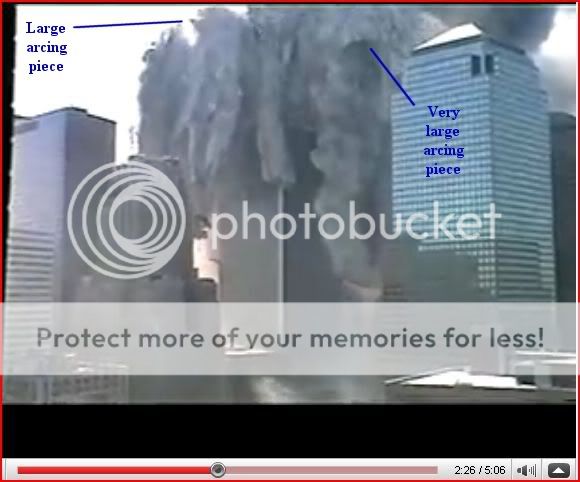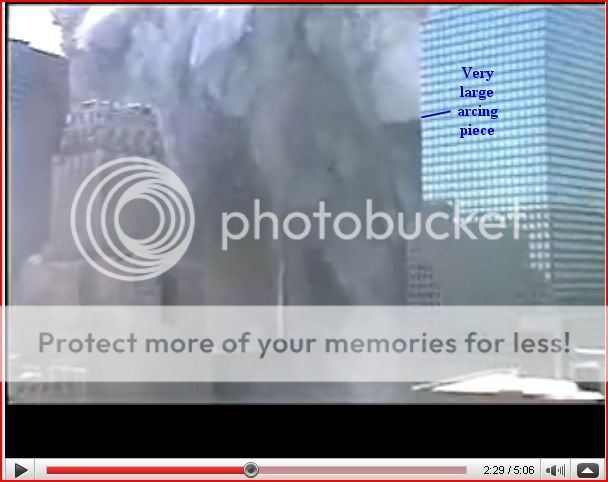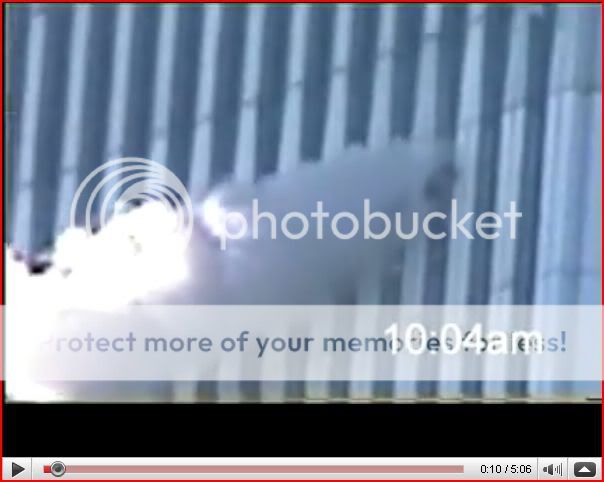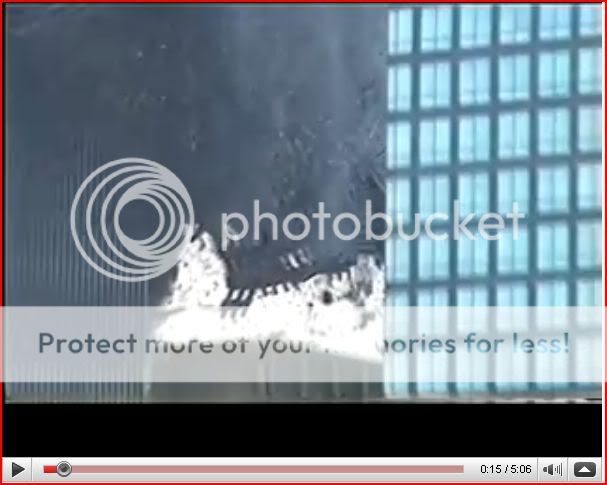It looks like you're using an Ad Blocker.
Please white-list or disable AboveTopSecret.com in your ad-blocking tool.
Thank you.
Some features of ATS will be disabled while you continue to use an ad-blocker.
share:
reply to post by Seymour Butz
The more I see of Mr Mackey's work the more I admire it. I also see Griff's point re thermobarics in that less of an impulse applied for a disproportionately longer time is capable of imparting higher velocities IE heaving as opposed to kicking. The point about absent smaller shrapnel moving at higher velocity is a very important one to consider.
We'd still be looking at devices the size of 44 gallon drums or larger and lots of them and I've yet to see any sign of even 1 such explosion taking place and they'd be extremely visible if actually used.
How well would a thermobaric or fuel-air explosive perform on a target that's already burning?
The more I see of Mr Mackey's work the more I admire it. I also see Griff's point re thermobarics in that less of an impulse applied for a disproportionately longer time is capable of imparting higher velocities IE heaving as opposed to kicking. The point about absent smaller shrapnel moving at higher velocity is a very important one to consider.
We'd still be looking at devices the size of 44 gallon drums or larger and lots of them and I've yet to see any sign of even 1 such explosion taking place and they'd be extremely visible if actually used.
How well would a thermobaric or fuel-air explosive perform on a target that's already burning?
A newly released high resolution edited video of the South Tower, North Tower, and WTC 7 demolitions. Larger video versions located
here. Patience required; this high resolution video takes a long time to load. A
high quality DivX version can be downloaded from the right side of the YouTube video and viewed with a DivX player. It looks real good and you will
have your own copy for posterity.
North Tower showing explosive hurling of heavy steel exterior wall sections up and out.



South Tower
Doesn't look like smoke - looks like a lot of steam



[edit on 12/8/08 by SPreston]
North Tower showing explosive hurling of heavy steel exterior wall sections up and out.



South Tower
Doesn't look like smoke - looks like a lot of steam



[edit on 12/8/08 by SPreston]
REALLY SPreston, I wish you would stop using the term "UP" when reffering to parts of the structure (inner or outer) being hurled anywhere.
We can all see the stuff FALLING DOWN, some parts going a little to what I would say is the SIDES of the building. But the only things going UP are smoke, dust, maybe some small debris, and that´s it. You are using the term "UP" to get it into the picture and the discussion.
Curious to know what happened to the sound on that first video. Sound would be "PRICELESS" on that piece since it would show the "explosions" clearly don´t you agree?
On the other hand, for the second tower I guess you have discovered a new angle of the "demolition", not only was it "top down", but also it was "from the outside to inside" because we can all see the inner structure standing after most of the building has collapsed. GREAT FIND!!
We can all see the stuff FALLING DOWN, some parts going a little to what I would say is the SIDES of the building. But the only things going UP are smoke, dust, maybe some small debris, and that´s it. You are using the term "UP" to get it into the picture and the discussion.
Curious to know what happened to the sound on that first video. Sound would be "PRICELESS" on that piece since it would show the "explosions" clearly don´t you agree?
On the other hand, for the second tower I guess you have discovered a new angle of the "demolition", not only was it "top down", but also it was "from the outside to inside" because we can all see the inner structure standing after most of the building has collapsed. GREAT FIND!!
Originally posted by exponent
The towers were well over 500ft tall and stored huge amounts of potential energy.
This might have been covered but it has to be mentioned cause it shows the lack of education we're dealing with here. I keep hearing about 'potential energy' from you and other debunkers and I know it's been explained, so why do you keep insisting on using hollywood physics?
You don't know what 'potential energy' is do you?
Potential energy is stored energy that tends to pull an object back to it's original position when subject to an external force, like a spring that is depressed and then let go.
Were those outer column sections under pressure like a spring waiting to be ejected when released? lol, I hope you said no.
What potential energy would cause exterior columns to be ejected 600 feet? Answer, none. Unless the building designers were stupid.
You all keep asking for proof of explosives but you can't explain how it could have happened without explosives without reverting to hollywood physics. Why do you insist on direct evidence when circumstantial evidence is in abundance here?
Nurse Melanie McGuire was convicted today of murdering her husband, dismembering him and dumping his body in the Chesapeake Bay. It was an entirely circumstantial case
You don't have to believe me, but it would do you a lot of good to go learn something about what you are trying to desperately claim.
Originally posted by ANOK
You all keep asking for proof of explosives but you can't explain how it could have happened without explosives without reverting to hollywood physics. Why do you insist on direct evidence when circumstantial evidence is in abundance here?
I say that they could have simply tipped out and reached out 500' with ease.
There, I've made a plausible case how the ext column trees could have reached the Winter Garden.
Now, will you be the first truther to put forth a working hypothesis for how much explosives, of any type you wish to use, that would be needed to "blow" just ONE ext column 500'?
Originally posted by Pilgrum
1-The more I see of Mr Mackey's work the more I admire it.
2- I also see Griff's point re thermobarics in that less of an impulse applied for a disproportionately longer time is capable of imparting higher velocities IE heaving as opposed to kicking.
1- yeah, I like to use his work to point out that claims of doing this is "futile" to be false. Just once, I'd like to see some real effort at some kind of attempt to falsify a truthers working hypothesis.
2- He's absolutley got a point. But the type of information needed to adjust for whatever type of explosive that one would like to propose is available on the net. Too bad that no one wants to do it.
Originally posted by Seymour Butz
I say that they could have simply tipped out and reached out 500' with ease.
Lol now I know you're not being serious. Physics is not your strong point either is it? Either that or you're just not being serious.
How about you explain exactly how those columns "reached out 500' with ease", please show in detail with precedence how this could happen?
Showing how much explosive it would require to eject those columns is pointless, what would that prove to you? Are you trying to claim that it can't be done because it took no explosives to eject those columns? Even if that is the case you could still come up with an amount of explosives that would 'also' do the ejecting, no?
Your logic is so twisted you don't even realise you're not making any sense.
Originally posted by Seymour Butz
I say that they could have simply tipped out and reached out 500' with ease.
You could state that, Seymour, if you wanted to ruin your reputation.
There, I've made a plausible case how the ext column trees could have reached the Winter Garden.
No, it's not plausible at all. Never.
500 feet is around 152 metres.
The tower collapsed in maybe 15 seconds or so (although one official report stated 10 seconds).
Therefore, a 4 ton section of outershell, near the top of the tower, needed to travel around 152 metres in 15 seconds which is around 10.1 metres/second, or around 36.4 km/hour.
A 4 ton section of steel frame can not be 'simply tipped out' with a horizontal velocity vector of 36.4 km/hr. No way. Never, ever.
[edit on 8-12-2008 by tezzajw]
Originally posted by ANOK
How about you explain exactly how those columns "reached out 500' with ease", please show in detail with precedence how this could happen?
Sure, no problem. Matter of fact, I'll put just as much effort as you're likely to do to try and prove how explosives could do that:
1-
2-
Originally posted by Seymour Butz
Sure, no problem. Matter of fact, I'll put just as much effort as you're likely to do to try and prove how explosives could do that:
I'm having a hard time understanding your point here, are you just arguing for no reason?
Why does anyone have to prove explosives could do that when it's painfully obvious explosives could do that.
You have still yet to come up with a logical alternative to the explosives hypothesis. I can't prove explosives were used, you can't prove they weren't, but your explanation for the physical evidence we see is not logical. Government official documentation ignores it.
So where is the logical explanation that fits the governments version of events?
Oh and btw nice dodging around the other points you were called out on. Pretend it doesn't matter, move on and continue spreading the lies. I know your game mate!
Originally posted by ANOK
1-Why does anyone have to prove explosives could do that when it's painfully obvious explosives could do that.
2-You have still yet to come up with a logical alternative to the explosives hypothesis.
3- I can't prove explosives were used, you can't prove they weren't,
1- Of course explosives COULD do it. The point is, you and everyone else is unwilling to make an attempt at falsifying the working hypothesis. Namely, if you WERE to do the calcs regarding the amount of explosives needed, the amount needed would be astronomical. Mr Mackey did a rough calc that to propel a single column tree, weighing... 6 tons?... would need a 1500 lb charge.... And if you think that it's possible for that to go unnoticed....
2- yes I did. If a large column tree, say 200-300', was to tip out from a height of 600'... the base would only need to hit 200-300' away from the base of the towers. This changes the numbers, right? And once the top of those column trees started tipping, they would achieve a horizontal momentum that would have to be maintained, according to all known physics. Agree?
3- yes I can disprove it, using Mackeys rough calculation of 1500 lbs of explosives that would be needed to fit "your" working hypothesis. Since a blast this large would be unmistakable, and it wasn't heard, it is proven that there were no explosives used, unless you're willing to say that sooper seekrit hush-a-boom explosives were used. Do you?
Originally posted by Pilgrum
How well would a thermobaric or fuel-air explosive perform on a target that's already burning?
It is my understanding that if it is a thermxte thermobaric, the ignition temperature would be far greater than a normal hydrocarbon fire. But, I could be incorrect.
reply to post by Seymour Butz
Seymour,
Tell me: Is this overpressure that Mackey describes for regular explosives or thermobarics?
www.sukip.com...
secondsightresearch.tripod.com...
en.wikipedia.org...
en.wikipedia.org...
en.wikipedia.org...
en.wikipedia.org...
Shall I continue?
Maybe Mr. mackey would like to investigate thermobarics instead of just calculating the pressure waves of normal HE?
[edit on 12/9/2008 by Griff]
Seymour,
Tell me: Is this overpressure that Mackey describes for regular explosives or thermobarics?
Unlike traditional bombs, which are focused on achieving maximum fragmentation and penetration, thermobaric bombs relies more on utilising heat and pressure effects. Such a bomb detonates in two stages — in the first stage, a small part of the energy is released.
The main explosive materials are then dispersed in air and they form a cloud-like structure. The explosive either ignites spontaneously, or after a second explosion. This explosion generates a pressure wave that has a greater reach than a conventional explosive, because most of the energy of a conventional bomb is used in providing the necessary acceleration to the fragments.
An ultrasonic shockwave and an incredibly high temperature cause most of the destruction in the case of a thermobaric bomb. The consumption of gases in the blast also generates a partial vacuum that can compound damage and injuries caused by the explosion itself. The weapon creates a huge pressure wave, which effectively sucks the air out of the lungs of anyone within range.
www.sukip.com...
For security reasons, he declined to give specifics about how thermobaric warheads are designed. However, generally they are believed to use highly flammable metal particles mixed with a liquid high explosive. When ignited in a two-stage process, the device creates a super-high heat and pressure blast capable of flattening buildings and rupturing organs in people near the detonation point.
secondsightresearch.tripod.com...
Rather than providing protection as they would from conventional explosive ammunition, structure interior walls, particularly cement or other hard surfaces, magnify and channel the shockwaves created by a thermobaric detonation. The stronger the walls, the higher the pressure’s reflective effect. The turbulent mixing of fuel with ambient oxygen is induced by the presence of walls through enhanced mixing from three different types of instabilities as well as from enhanced chemistry from temperature and pressure velocity gradient in differing fuels,creating a piston type afterburn reaction in enclosed structures
en.wikipedia.org...
In confined spaces, transition to full detonation is not required for enhanced blast, if the solid fuel is ignited early in the dispersion process. A series of reflective shock waves generated by the detonation mixes the hot detonation gasses with metal particles and compresses the metal particles at the same time. These actions provide the chemical kinetic support to maintain a hot environment, causing more metal to ignite and burn. This late time metal combustion process produces a significant pressure rise over a longer time duration (10–50 msec). This is a phase generally referred to as after burning or late-time impulse which can occur outside of where the detonation occurred, resulting in more widespread damage.[5]
This is an aerobic reaction that draws in all of the unburnt fuel and atmospheric air, and creates a vacuum in the detonation environment.An air shock wave, generated during the fireball expansion, is reflected from the walls of the structure. The reflected shock plays two important roles. First, it stops the temperature decrease of the air and the fireball. It can actually increase the temperature in some places, depending on how the shock waves are bouncing back and forth. Second, it creates two new types of flow instabilities; Richtmyer-Meshkov and Kelvin-Helmholtz instabilities.
en.wikipedia.org...
Stage One defines the HE's high-pressure shock effects (such as propelling a metal liner or fragments); Stage Two prolongs the high-pressure blast pulse, giving a useful heaving effect needed in building or bunker defeat; and Stage Three produces a long-duration, lower-pressure pulse that can also have a high thermal output, both of which are useful for materiel and personnel defeat.
en.wikipedia.org...
Blast enhancement is mainly due to two reasons. The first is the fact of the wide dispersion of the fuel before combustion, making the initial combustion zone very large in comparison with a standard high explosive (metres compared with millimetres). The second is that although the peak pressure produced is lower, the duration is far longer. This is effective as the ability of buildings and people to survive a given pulse pressure level decreases with increasing pulse duration. The thermal effects of such warheads also dwarf those of classical HE, the temperature of the fireball, the heat flux produced and its duration all being several times larger (some an order of magnitude greater).
en.wikipedia.org...
Shall I continue?
Maybe Mr. mackey would like to investigate thermobarics instead of just calculating the pressure waves of normal HE?
[edit on 12/9/2008 by Griff]
Originally posted by Seymour Butz
Namely, if you WERE to do the calcs regarding the amount of explosives needed, the amount needed would be astronomical.
Hehe this is like your 'it would take thousands of tons of explosives so it must have been caused by office fires' BS.
It would take an astronomical amount of explosives? Yet you believe it just happened naturally with no explosives? Again you don't even realise you are contradicting yourself.
2- yes I did. If a large column tree, say 200-300', was to tip out from a height of 600'... the base would only need to hit 200-300' away from the base of the towers. This changes the numbers, right? And once the top of those column trees started tipping, they would achieve a horizontal momentum that would have to be maintained, according to all known physics. Agree?
No I don't agree, you're talking nonsense. The columns didn't 'tip over', you know very well they didn't.
Horizontal momentum has to be maintained? According to who? What exactly is going to maintain that 'horizontal momentum'?
Sorry mate but you're just once again proving your lack of education.
Understanding physics is very important to understanding the events we're discussing don't ya think?
First you have to explain how those columns are moving 'horizontally', I thought they just dropped straight down?
Also why we're here please explain how column sections simply 'dropping' with no force behind them could have caused so much damage to WTC7? You can't have it both ways matey.
3- yes I can disprove it, using Mackeys rough calculation of 1500 lbs of explosives that would be needed to fit "your" working hypothesis.
Just because you heard no big boom it doesn't mean you are right.
You can't disprove anything. First you have to prove that it's even physically possible for the column sections to do what you're claiming without reverting to hollywood physics, which you have failed to do.
Also loud bangs were heard, you know it so stop with the lying. You can find excuses for those loud bags, but you can't simply deny them.
Originally posted by tezzajw
A 4 ton section of steel frame can not be 'simply tipped out' with a horizontal velocity vector of 36.4 km/hr. No way. Never, ever.
The more important proof that debunks that theory is that the fulcrums were visibly severed in the vast majority of cases. There was no "tipping" or "leaning" once the connections to the building were destroyed and the debris was just sailing out over open air on its own.
Originally posted by ANOK
Originally posted by Seymour Butz
I say that they could have simply tipped out and reached out 500' with ease.
Lol now I know you're not being serious. Physics is not your strong point either is it? Either that or you're just not being serious.
How about you explain exactly how those columns "reached out 500' with ease", please show in detail with precedence how this could happen?
Showing how much explosive it would require to eject those columns is pointless, what would that prove to you? Are you trying to claim that it can't be done because it took no explosives to eject those columns? Even if that is the case you could still come up with an amount of explosives that would 'also' do the ejecting, no?
Your logic is so twisted you don't even realise you're not making any sense.
Either physics is not his strong point or he is not being serious... That's a false dilemma. Do not call him on his logic if your own is no better when criticizing him. How much explosive needed is not a pointless inquiry especially because knowledge of it could be a counterpoint to other arguments established on these forums.
I see in a later post you have constructed a straw man argument calling his argument BS while constructing it for yourself. You make out that he believes that the cause of the 500 foot shift was due to office fires. Because office fires are less dynamic then explosives, you say his statement is self defeating. It isn't. The fires were only part of the many things that went into the 500' shift. The airplane, the fires, the structure weakened, the chaotic nature of the collapse. What he is trying to say is that explosives are not the only possible explanation for why we observed what we observed.
[edit on 9-12-2008 by newagent89]
reply to post by Griff
Lookey, lookey what I found.
www.nationalterroralert.com...
Lookey, lookey what I found.
Thermobaric bombs, al Qaeda’s new weapon of destruction, raises the stakes in the war on terror.
www.nationalterroralert.com...
Originally posted by Griff
Maybe Mr. mackey would like to investigate thermobarics instead of just calculating the pressure waves of normal HE?
Hey, I have an idea......
Why don't you make an attempt at falsifying your working hypothesis?
Since you seem to have some info, it shouldn't be too hard.
Originally posted by Seymour Butz
Since you seem to have some info, it shouldn't be too hard.
Don't worry. When I get time I'll shoot Mackey down yet again.
Originally posted by ANOK
1-It would take an astronomical amount of explosives? Yet you believe it just happened naturally with no explosives? Again you don't even realise you are contradicting yourself.
2-No I don't agree, you're talking nonsense. The columns didn't 'tip over', you know very well they didn't.
3-Horizontal momentum has to be maintained?
4-Understanding physics is very important to understanding the events we're discussing don't ya think?
5-First you have to explain how those columns are moving 'horizontally', I thought they just dropped straight down?
6-Also why we're here please explain how column sections simply 'dropping' with no force behind them could have caused so much damage to WTC7? You can't have it both ways matey.
7-Just because you heard no big boom it doesn't mean you are right.
8-You can't disprove anything.
9-First you have to prove that it's even physically possible for the column sections to do what you're claiming without reverting to hollywood physics, which you have failed to do.
10-Also loud bangs were heard, you know it so stop with the lying. You can find excuses for those loud bags, but you can't simply deny them.
1- uhhhh no. You're the one pushing the claim that only explosives could explain the columns being where they ended up. I'm saying that the explosives needed to do that would have to be huge and undeniable. There would also be other effects from these blasts like small sized shrapnel being blown all over the place. I'm sorry if you don't see the difference. I'm also saying there's an explanation that you are ignoring.
2- you're kidding, right? Should I post a utube showing exactly that? Or would you rather just save face now and admit you're lying?
3- the horizontal momentum achieved by the tipping motion. The top of a long column tree, before it breaks off, will achieve a lateral velocity. Once it gets going, air resistance alone won't do much to slow it down. The only way to deny this is to deny that the ext columns tipped when the connections to the floors failed. Again, should I post a utube showing exactly that? Or would you rather just save face now and admit you're lying?
4- and unfortunately, any physics you think you learned from DGR is wrong and stupid.
5- I thought the claim by truthers is that they were "blown" 500' by explosives? Make up your mind already.
6- no force? Ok, tell ya what, get anvil and hold it 2' over your foot, then drop it onto your foot and tell us about how you felt nothing because there was "no force".
7- yes, it does.
8- I already proved that the explosives would have been massive if they were the sole reason that the ext columns ended up where they were.
9- so falling objects = hollywood physics now? How's that work again?
10 well, you can prove me wrong then. I say that there were explosions, yes. But no explosives. Again, you can prove me wrong by doing the calcs necessary. If a 1 lb hush-a-boom will do the job, then you've won the argument. Somehow, I think all I'll get is handwaving about how it's "futile".....
new topics
-
The art of being offended
Social Issues and Civil Unrest: 27 minutes ago -
FLORIDA Sues Biden-Harris FEMA for Denying Disaster Assistance to Homeowners with TRUMP Signs.
US Political Madness: 1 hours ago -
Turns out, they planned to go after P-nut.
US Political Madness: 5 hours ago -
Sick sick sick
Social Issues and Civil Unrest: 11 hours ago
top topics
-
Comcast dumping MSNBC
Mainstream News: 13 hours ago, 22 flags -
President-elect TRUMP Picks MATT GAETZ for his ATTORNEY GENERAL - High Level PANIC Ensues.
2024 Elections: 17 hours ago, 17 flags -
Turns out, they planned to go after P-nut.
US Political Madness: 5 hours ago, 15 flags -
Sick sick sick
Social Issues and Civil Unrest: 11 hours ago, 7 flags -
FLORIDA Sues Biden-Harris FEMA for Denying Disaster Assistance to Homeowners with TRUMP Signs.
US Political Madness: 1 hours ago, 4 flags -
The art of being offended
Social Issues and Civil Unrest: 27 minutes ago, 2 flags
active topics
-
The art of being offended
Social Issues and Civil Unrest • 4 • : SprocketUK -
The Trump effect 6 days after 2024 election
2024 Elections • 107 • : cherokeetroy -
WATCH LIVE: US Congress hearing on UFOs, unidentified anomalous phenomena
Aliens and UFOs • 45 • : putnam6 -
The Reactionary Conspiracy 13. The plot’s theology.
General Conspiracies • 295 • : Oldcarpy2 -
Critical shortcomings of the Patriot complex
Weaponry • 97 • : Zaphod58 -
FLORIDA Sues Biden-Harris FEMA for Denying Disaster Assistance to Homeowners with TRUMP Signs.
US Political Madness • 13 • : marg6043 -
-@TH3WH17ERABB17- -Q- ---TIME TO SHOW THE WORLD--- -Part- --44--
Dissecting Disinformation • 3267 • : Thoughtful3 -
Comcast dumping MSNBC
Mainstream News • 20 • : WeMustCare -
Over 1,100 Migrants Arrived in First 10 Days of Labour Government
Social Issues and Civil Unrest • 442 • : angelchemuel -
Should we look for the truth, or just let it go?
US Political Madness • 110 • : PorkChop96
